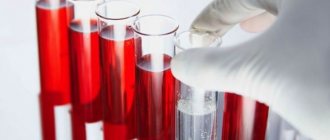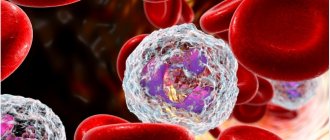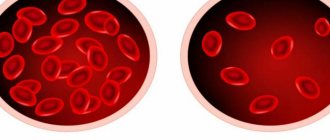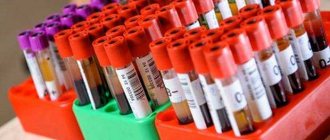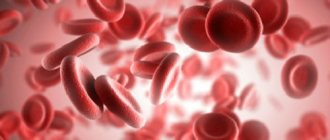Decoding the results
Increased D-dimer levels
When the level of D-dimer in the blood increases, it is necessary to search for a probable cause, since some conditions accompanied by an increase in its concentration require immediate medical attention.
An increased level of D-dimer as a physiological norm occurs in old age (after eighty years), as well as during pregnancy (gradually increasing in proportion to the gestational age).
- Outside of pregnancy, a high D-dimer may indicate the presence of thrombosis in the veins or arteries. This is usually accompanied by complaints characteristic of thrombosis (pain in the limb, swelling, redness or pallor) or thromboembolism (shortness of breath, chest pain, hemoptysis). In this case, help must be urgent. But in approximately 20-30% of cases, thrombosis is asymptomatic. In this case, your doctor will help you draw up an examination plan and decide on tactics.
- D-dimer often increases in people suffering from obesity, autoimmune diseases (rheumatoid arthritis, systemic lupus erythematosus, etc.), as well as liver disease and cancer. In this case, the increase is most likely secondary, and if there are no signs of thrombosis, observation by your doctor is sufficient.
- Often, D-dimer is elevated in older people (also without signs of thrombosis). Prescribing thinning drugs in this situation is not always necessary, since the risk of bleeding must also be taken into account.
- Since D-dimers are breakdown products of already formed blood clots, their concentration may increase after bleeding or during the period of hematoma resorption.
- The most difficult thing to interpret is the increase in D-dimer due to thrombosis during pregnancy. The same level of D-dimer can be observed both in a patient with thrombosis and in a healthy pregnant woman. Therefore, complaints and the likelihood of thrombosis (the degree of risk, which is calculated on a special scale) are always assessed in parallel.
Normal D-dimer levels
A normal test result indicates that the patient is not at risk of thrombosis. However, in rare cases (no more than 2 per hundred) in the presence of thrombosis, the level of D-dimer remains normal. As a rule, this is due either to the very small size of the blood clot, or to improper storage of the material for the study. Thus, the diagnostic value of the D-dimer test is quite high (98%) and allows its active use to exclude the process of thrombus formation.
Low D-dimer levels
A low D-dimer should not be a concern. If the value is below the lower limit (although most laboratories indicate only the upper limit, which is correct), this can reliably indicate only one thing: you definitely do not have thrombosis.
It makes no difference whether to take a D-dimer test before or after taking thinning drugs, since this indicator is cumulative and reflects the activity of the coagulation and anticoagulation systems retrospectively.
Caution: blood clot!
Ten years ago, a coagulogram was a “for show” analysis. Many still have before their eyes a shot from a black and white film of a nurse sitting at a test tube with a stopwatch and determining the time of blood clotting. But a lot has changed since then. Now, with the help of a coagulogram, you can not only find out everything about the work of your own coagulation system, but also predict whether you are generally susceptible to the formation of blood clots. The first stage is a regular coagulogram. If it reveals deviations from the norm, the next step will be a detailed coagulogram . It shows the full range of possible bleeding disorders. A separate story is the determination of the Leiden mutation and D-dimer - tests that reveal a tendency to form blood clots in the future. What is necessary and in what cases? We provide answers to your questions.
Who needs a regular coagulogram?
Everyone needs to do it periodically. This is a routine screening, like a general blood test or sugar level determination. Includes four components: prothrombin index (PTI), APTT, fibrinogen and platelet levels. Another INR indicator is useful for people who are constantly taking blood thinning medications. If all values are normal, your blood clotting is fine.
WHAT IS A THROMBUS This is our savior. If a vessel is damaged, a clot of coagulated blood closes the “gap.” But in some situations, a blood clot turns into a killer. Any injury or surgery plus excessive activity of the coagulation system - and now a blood clot from the vein enters the pulmonary artery. In Russia, 100 thousand people a year die for this reason - more than in car accidents, regional conflicts and criminal incidents combined.
So you don’t have to be afraid of blood clots?
Take the test
For a healthy person - yes. But if you have varicose veins, arterial hypertension, atrial fibrillation or coronary heart disease, you need to play it safe and take a detailed coagulogram. Moreover, evaluate not only the performance of various components, but also the fluidity (rheology) of the blood. And do a D-dimer test. This indicator is actively used to determine the risk of blood clots. People with a negative result have virtually no blood clots, and those with elevated D-dimer are at much higher risk than others.
Is there a genetic test for a tendency to thrombosis? Yes. This is a test for the Leiden mutation, which occurs in 2–6% of Europeans. The presence of a defective gene increases the likelihood of venous blood clots 6–8 times, and the risk of heart attack and stroke increases significantly. Early treatment reduces the risk of dangerous complications.
Who should be tested for D-dimer and Leiden mutation first? Those whose immediate relatives have suffered thromboembolism, who have already had cases of thrombosis. It is imperative to monitor D-dimer in case of venous diseases (thrombophlebitis), after surgical interventions and upon discharge from the hospital if you have been bedridden for a long time. It is necessary to monitor D-dimer levels during pregnancy and when taking hormonal contraceptives (the risk of blood clots in the presence of the Leiden mutation while taking birth control pills increases almost 9 times). Patients at risk of stroke and heart attack cannot do without determining D-dimer.
D-DIMER IS NEEDED IF YOU:
* have undergone surgery or are about to undergo it; * planning a pregnancy; * taking hormonal contraceptives; * suffer from varicose veins; * have cardiovascular diseases.
How accurate are the study results? Choose a good laboratory for D-dimer determination. You can completely trust only the results of studies conducted on modern equipment with proprietary sensitive test systems. It makes sense to compare results over time only if the tests were taken in the same laboratory.
What should I do if I am at risk? Do not panic. Most likely, you will be prescribed blood thinning medications (note: for a heart patient and a patient with varicose veins, these will be different medications). Try to reduce the number of risk factors: treat atrial fibrillation, remove varicose veins. And be sure to show the results of the study to your hematologist. You can periodically take a repeat coagulogram. Or purchase a portable coagulometer - a device with which you can evaluate the effectiveness of medicinal blood thinning at home.
How to prepare for a coagulogram? The test is taken in the morning on an empty stomach. If you are taking blood thinning medications, you should stop taking them 7-10 days before the test.
Alexey Fedorov
Published: August 24, 2021
D-dimer during pregnancy
D-dimer concentrations increase during pregnancy, which is normal. During this period, the hemostasis system of the expectant mother undergoes changes: the total volume of blood increases, and almost all its indicators change.
D-dimer levels increase throughout gestation, increasing up to several times at the time of birth. It should be noted that there are no clear reference values for pregnant women.
In pregnant women, the level of D-dimer can exceed the norm (even the norm for the duration of pregnancy) many times, especially in the second half of pregnancy. This is a normal physiological reaction of the blood coagulation system. However, in some cases, elevated D-dimer can also be a harbinger of obstetric complications. Therefore, although a high D-dimer in pregnant women itself is not an indication for treatment, this phenomenon requires a thorough analysis by a hemostasiologist of all risk factors in order to make a decision on prescribing or not prescribing drugs.
Preparing for analysis
Like any other test for collecting venous blood, it must be taken in the morning on an empty stomach (the last meal is 8-10 hours before). Before the analysis, you are allowed to drink still water. It is permissible to donate blood during the day, but only 4 hours after a light meal.
The day before taking blood, any psycho-emotional and physical stress and alcohol intake are usually excluded. You should not smoke half an hour before the procedure, including electronic cigarettes.
Important! The results are released within 24 hours, and the day of blood donation is not included in the calculation. The result may be distorted if the preparation rules and anticoagulants are not followed.
D-dimer in the IVF program
During the period of superovulation stimulation, D-dimer often increases rapidly. This is a fairly common manifestation of the effect of stimulating drugs on hemostasis. It should be remembered that the increase in D-dimer lags behind the actual activation of coagulation by 5-7 days.
The maximum activity of the hemostatic system is observed on the day of follicle puncture, but D-dimer reaches its peak only 5-7 days after it, when the embryo is transferred. Therefore, it seems to patients that the D-dimer has increased due to transfer, although in fact during this period hemostasis is usually almost calm. In any case, a multiple increase in D-dimer during the IVF program (compared to the level that was before entering the protocol) requires attention and analysis of risk factors. This is necessary to determine whether thinning medications are required.
In the IVF protocol, thrombotic complications are possible against the background of stimulation of ovarian function, predisposing to the development of ovarian hyperstimulation syndrome (OHSS) of varying severity and against the background of implantation and development of the embryo. In this regard, anticoagulant therapy is used during the IVF protocol and pregnancy. With OHSS, hypercoagulation develops, which determines a high risk of thrombotic complications, development of disseminated intravascular coagulation, and microthrombosis localized primarily in the uterus. These situations are dangerous to the health and life of patients, in addition, they contribute to implantation failure and complicate the course of pregnancy. When assessing the blood coagulation system, an increase in the concentration of D-dimer and other markers of thrombinemia is one of the main indicators for drug therapy.
At Nova Clinic you can make an appointment with a specialist in the field of hemostasis by calling the phone number listed on the website or using the booking button. You can find out more about what you need to take with you to your first appointment in the “Consultation with a hemostasiologist” section.
Indications for analysis
Main indications for analysis:
- identification of thrombotic conditions;
- age over 80 years;
- VTEC diagnosis:
- DIC syndrome;
- pulmonary thromboembolism (PE);
- stroke and heart attack;
- deep vein thrombosis, etc.
In addition, analysis is prescribed in the following cases:
- Monitoring of ongoing treatment with thrombolytics or anticoagulants. Determinations based on this duration of therapy.
- Forecast of the course of diseases of the cardiovascular system.
- Long-term use of combined oral contraceptives or hormone replacement therapy.
What to do if D-dimer is elevated
If the level is slightly exceeded and the patient is feeling normal, treatment can be carried out in a day hospital. Therapy includes injections and drips of blood thinning drugs.
The following recommendations will also help reduce D-dimer (but they will not replace the main treatment):
- Drink more pure still water;
- Do physical exercise (special classes for pregnant women and water aerobics are especially useful);
- Walk more in the fresh air;
- Don't overwork yourself;
- Pay attention to proper nutrition.
Important! If any of your relatives suffered from blood clotting disorders during pregnancy, you are at increased risk of thrombotic complications. In this case, consultation with a geneticist is recommended, since in some cases these pathologies are inherited. It is advisable to do this at the stage of pregnancy planning.
Treatment tactics
An increased dimer concentration indicates the need for treatment. Otherwise, severe pregnancy complications are possible.
First of all, the doctor prescribes drugs that normalize the rheological properties of the blood and prevent the formation of blood clots. For this purpose, pregnant women are recommended to administer intravenous solutions that improve the functioning of the microvasculature and indirect anticoagulants. Treatment is carried out on an outpatient basis, less often in a hospital setting. It is very important to monitor D-dimer and blood clotting over time.
If the dimer is reduced, the woman is prescribed coagulants, vitamin K preparations, and in severe cases, platelet transfusions.
Before prescribing treatment, the doctor should understand that the D-dimer blood test is a relatively new test that often gives false positive results. Patients of the Altravita reproductive medicine clinic are recommended to donate blood at a local laboratory. It is equipped according to the latest international requirements, and the medical staff has extensive experience. This allows you to reduce the risk of diagnostic error to a minimum.
Blood test for D-dimer after coronavirus
COVID-19 is an infection that has a negative impact not only on the respiratory system, but also on the hemostatic system. Coronavirus is associated with increased blood clotting. In patients who have recovered from Covid, large blood clots are often detected in the pulmonary arteries, vessels of the brain and internal organs.
An increased level of D dimer after coronavirus indicates that the patient has suffered a severe form of the disease. A person remains at risk of myocardial damage and the development of respiratory failure.
Based on the test results, the doctor will be able to select effective anticoagulant (blood thinning) therapy. This will speed up the recovery period.
What should the normal indicator be?
The normal level of D-dimer in blood plasma is 250 ng/ml. this indicator confirms that the patient is not at risk of thrombosis. In pregnant women, this figure can reach 1000 ng/ml or more, i.e. grow 3–4 times.
Normal D-dimer levels in pregnant women:
- up to 450–500 ng/ml in the 1st trimester;
- up to 900–920 ng/ml in the 2nd trimester;
- up to 1450–1500 ng/ml in the 3rd trimester.
If a pregnant woman, on the contrary, has a low level, she is urgently referred to a hematologist, who will prescribe medications. A decrease in dedimer during pregnancy is a sign of long-standing problems with blood clotting that arose long before pregnancy. With good treatment, childbirth proceeds normally.
